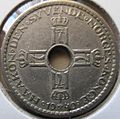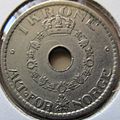Norwegian krone facts for kids
Quick facts for kids Norwegian krone |
|||
|---|---|---|---|
|
|||
| ISO 4217 Code | NOK | ||
| User(s) | |||
| Inflation | 5.4% (April 2022) | ||
| Source | Norges bank | ||
| Subunit | |||
| 1⁄100 | øre | ||
| Symbol | kr | ||
| Plural | kroner | ||
| øre | øre | ||
| Coins | 1, 5, 10, 20 kroner | ||
| Banknotes | |||
| Freq. used | 50, 100, 200, 500 kroner | ||
| Rarely used | 1000 kroner | ||
The krone (pronounced "kroo-nuh") is the money used in Norway. Its symbol is kr. People sometimes call it the Norwegian crown in English, but this is not common anymore.
One krone used to be divided into 100 øre. However, the last øre coins were stopped in 2012. This means you won't find them in your change today.
The Norwegian krone is an important currency around the world. In April 2010, it was the 13th most traded currency.
You might find that Norwegian krone are sometimes accepted in shops near the border in Sweden and Finland. They are also used in some ferry ports in Denmark. Many Norwegians like to shop across the border. They often buy food, drinks, and tobacco there. This is because these items can be much cheaper outside Norway due to lower taxes.
Contents
History of the Norwegian Krone
The krone was first used in 1875. It replaced the old money called the Norwegian speciedaler. Four kroner were equal to one speciedaler.
When the krone was introduced, Norway joined the Scandinavian Monetary Union. This union started in 1873. It meant that the money in Norway, Denmark, and Sweden could be exchanged equally. This system worked until 1914, when World War I began. After the war, the currencies of these countries were no longer worth the same.
In the Scandinavian Monetary Union, the krone was linked to gold. This was called the gold standard. It meant that 2,480 kroner were worth one kilogram of pure gold. This gold standard was paused during and after the world wars. It was permanently stopped in 1931.
Later, the krone's value was linked to other currencies. In 1933, it was linked to the pound sterling. One pound was worth 19.9 kroner. In 1939, it was linked to the U.S. dollar. One dollar was worth 4.4 kroner.
During the German occupation in World War II, the krone was linked to the German Reichsmark. After the war, new exchange rates were set.
In 1992, the Norges Bank, which is Norway's central bank, changed how the krone's value was set. They decided to let its value float freely. This means the krone's value now changes based on the market.
Types of Coins and Banknotes Over Time
This table shows the different types of coins and banknotes that have been used in Norway:
| Value | Banknotes | Coins | ||||
|---|---|---|---|---|---|---|
| Printed | No Longer Valid | Notes | Minted | No Longer Valid | Notes | |
| 1 øre | — | 1876–1972 | 1988 | Made of bronze, or iron during wartime (1918–1921 & 1941–1945) | ||
| 2 øre | — | 1876–1972 | 1988 | Made of bronze, or iron during wartime (1917–1920 & 1943–1945) | ||
| 5 øre | — | 1875–1982 | 1988 | Made of bronze, or iron during wartime (1917–1920 & 1941–1945) | ||
| 10 øre | — | 1874–1991 | 2003 | Silver (1874–1919), then cupro-nickel (1920–92), zinc during wartime (1941–1945) | ||
| 25 øre | — | 1876–1982 | 1988 | Silver (1876–1919), then cupro-nickel (1921–82), zinc during wartime (1943–1945) | ||
| 50 øre | — | 1874–2012 | 2012 | Silver (1874–1919), then cupro-nickel (1920–96), zinc during wartime (1941–1945), then bronze (1996–2012) | ||
| 1 krone | 1917–1925 1940–1950 |
1926 1999 |
Special "coin notes" during wartime | 1875– | — | Silver (1875–1917), then cupro-nickel (1925–) |
| 2 kroner | 1918–1925 1940–1950 |
1926 1999 |
Special "coin notes" during wartime | 1876–1917 | 1922 | Silver (1878–1917) |
| 5 kroner | 1877–1963 | 1999 | Replaced by a coin in 1963 | 1963– | — | Cupro-nickel |
| 10 kroner | 1877–1984 | 1999 | Replaced by a coin in 1984 | 1983– | — | Nickel-brass |
| 20 kroner | — | 1994– | — | Nickel-brass | ||
| 50 kroner | 1877– | — | — | |||
| 100 kroner | 1877– | — | — | |||
| 200 kroner | 1994– | — | — | |||
| 500 kroner | 1877– | — | — | |||
| 1000 kroner | 1877– | — | — | |||
Norwegian Coins
Coins were first introduced in 1875. These included 10 and 50 øre, and 1 and 10 kroner. Over the next few years, more coins were added. These were 1, 2, 5, 10, 25, and 50 øre, and 1, 2, and 10 kroner.
The 1, 2, and 5 øre coins were made of bronze. The 10, 25, and 50 øre, and 1 and 2 kroner coins were made of silver. The 10 and 20 kroner coins were made of gold.
The last gold coins were made in 1910. Silver was replaced by a mix of copper and nickel in 1920. During World War II, zinc was used for some coins because other metals were scarce.
In 1963, 5 kroner coins were introduced. The making of 1 and 2 øre coins stopped in 1972. The 5-øre coin became smaller, and its production stopped in 1982. The 25 øre coin also stopped being made then. Ten-kroner coins were introduced in 1983. The last 10 øre coins were made in 1992.
Between 1994 and 1998, new coins were released. These were 50 øre, 1, 5, 10, and 20 kroner. Today, only the 1, 5, 10, and 20 kroner coins are used. The 50 øre coin was stopped on May 1, 2012. It was no longer used much for payments. However, banks would still exchange 50 øre coins until 2022.
Current Norwegian Coins
These are the coins you can use in Norway today:
| Currently circulating coins | ||||||||||
|---|---|---|---|---|---|---|---|---|---|---|
| Image | Value | Technical details | What they look like | First made | ||||||
| Front | Back | Size (mm) | Thickness (mm) | Weight (g) | Material | Edge | Front design | Back design | ||
 |
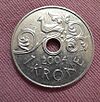 |
1 krone | 21 mm | 1.7 mm | 4.35 g | Cupronickel (75% Copper, 25% Nickel) |
Smooth | King Harald V's special symbol | A fowl (bird) | 1997 |
 |
 |
5 kroner | 26 mm | 2 mm | 7.85 g | Milled (grooved) | St. Olav's Order symbol | Acanthus leaves | 1998 | |
 |
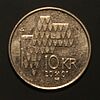 |
10 kroner | 24 mm | 2 mm | 6.8 g | (81% Copper, 10% Zinc, 9% Nickel) | Interrupted milling | King Harald V | A stave church roof | 1995 |
 |
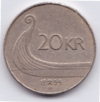 |
20 kroner | 27.5 mm | 2.2 mm | 9.9 g | Smooth | A Viking ship | 1994 | ||
| For table standards, see the coin specification table. | ||||||||||
The 10 and 20 kroner coins show a picture of the current king, King Harald V. His special saying, Alt for Norge (meaning "Everything for Norway"), is also on the 10 kroner coin. The 1 and 5 kroner coins have royal or national symbols.
The Norges Bank (Central Bank of Norway) is in charge of distributing all Norwegian coins and banknotes.
In Norway, you can pay with up to 25 coins of any single value. This is considered a legal way to pay.
Syrian Coins in Norway
Did you know that 10 Syrian pound coins look very similar to Norwegian 20 kroner coins? They are almost the same weight and size. Because of this, vending machines and other coin-operated machines in Norway sometimes get confused. They can't tell the difference between the two coins.
In 2017, a 10 Syrian pound coin was worth much less than a 20-kroner coin. Even though Syrian coins are not common in Norway, people sometimes used them in machines. Because of this, the Norwegian postal service (Posten Norge) even closed some of their coin machines in 2006. They wanted to create a system that could tell the coins apart.
Norwegian Banknotes
In 1877, the Norges Bank started printing banknotes. These included values of 5, 10, 50, 100, 500, and 1000 kroner.
During times when metal was scarce, like in the world wars, 1 krone and 2 kroner banknotes were printed. This happened from 1917 to 1922 and again from 1940 to 1950.
Over time, some banknotes were replaced by coins. The 5 kroner banknote was replaced by a coin in 1963. The 10 kroner banknote was replaced by a coin in 1984. In 1994, 200 kroner banknotes were introduced.
Current Norwegian Banknotes
Here are the banknotes that are currently used in Norway:
| Image | Value | Size (millimeters) |
Main Color | Design | First made | ||||
|---|---|---|---|---|---|---|---|---|---|
| Front | Back | Front design | Back design | ||||||
 |
 |
50 kr | 126 × 70 | Green | Utvær Lighthouse | A stylized lighthouse beam and the Big Dipper constellation | 2018 | ||
 |
 |
100 kr | 133 × 70 | Red | Gokstad ship (a Viking ship) | A stylized container ship, a globe, and the Orion constellation | 2017 | ||
 |
200 kr | 140 × 70 | Blue | A Codfish | A stylized fishing boat, a fishing net, and a beacon | 2017 | |||
| 500 kr | 147 × 70 | Orange | The rescue vessel RS 14 Stavanger | A stylized oil platform, gas pipelines from the North Sea, and an ammonite fossil | 2018 | ||||
| 1000 kr | 154 × 70 | Purple | A wave in the sea | A stylized horizon and water molecules | 2019 | ||||
| These images are to scale at 0.7 pixel per millimetre. For table standards, see the banknote specification table. | |||||||||
Exchange Rates
| Rank | Currency | ISO 4217 code (symbol) |
% daily share (April 2016) |
|||||||||||||||||||||||||||||||||||||||||||||||||||||||||||||||||||||||||||||||||||||||||||||||||||||||||||||||||||||||||||||||||||||||||||||||||||||||||||||||||||||||||||||||||||||||||||||||||||||||||||||||||||||||||||||||||||
|---|---|---|---|---|---|---|---|---|---|---|---|---|---|---|---|---|---|---|---|---|---|---|---|---|---|---|---|---|---|---|---|---|---|---|---|---|---|---|---|---|---|---|---|---|---|---|---|---|---|---|---|---|---|---|---|---|---|---|---|---|---|---|---|---|---|---|---|---|---|---|---|---|---|---|---|---|---|---|---|---|---|---|---|---|---|---|---|---|---|---|---|---|---|---|---|---|---|---|---|---|---|---|---|---|---|---|---|---|---|---|---|---|---|---|---|---|---|---|---|---|---|---|---|---|---|---|---|---|---|---|---|---|---|---|---|---|---|---|---|---|---|---|---|---|---|---|---|---|---|---|---|---|---|---|---|---|---|---|---|---|---|---|---|---|---|---|---|---|---|---|---|---|---|---|---|---|---|---|---|---|---|---|---|---|---|---|---|---|---|---|---|---|---|---|---|---|---|---|---|---|---|---|---|---|---|---|---|---|---|---|---|---|---|---|---|---|---|---|---|---|---|---|---|---|---|---|---|---|---|---|
|
|
|
87.6% | ||||||||||||||||||||||||||||||||||||||||||||||||||||||||||||||||||||||||||||||||||||||||||||||||||||||||||||||||||||||||||||||||||||||||||||||||||||||||||||||||||||||||||||||||||||||||||||||||||||||||||||||||||||||||||||||||||||
|
|
|
31.4% | ||||||||||||||||||||||||||||||||||||||||||||||||||||||||||||||||||||||||||||||||||||||||||||||||||||||||||||||||||||||||||||||||||||||||||||||||||||||||||||||||||||||||||||||||||||||||||||||||||||||||||||||||||||||||||||||||||||
|
|
|
21.6% | ||||||||||||||||||||||||||||||||||||||||||||||||||||||||||||||||||||||||||||||||||||||||||||||||||||||||||||||||||||||||||||||||||||||||||||||||||||||||||||||||||||||||||||||||||||||||||||||||||||||||||||||||||||||||||||||||||||
|
|
|
12.8% | ||||||||||||||||||||||||||||||||||||||||||||||||||||||||||||||||||||||||||||||||||||||||||||||||||||||||||||||||||||||||||||||||||||||||||||||||||||||||||||||||||||||||||||||||||||||||||||||||||||||||||||||||||||||||||||||||||||
|
|
|
6.9% | ||||||||||||||||||||||||||||||||||||||||||||||||||||||||||||||||||||||||||||||||||||||||||||||||||||||||||||||||||||||||||||||||||||||||||||||||||||||||||||||||||||||||||||||||||||||||||||||||||||||||||||||||||||||||||||||||||||
|
|
|
5.1% | ||||||||||||||||||||||||||||||||||||||||||||||||||||||||||||||||||||||||||||||||||||||||||||||||||||||||||||||||||||||||||||||||||||||||||||||||||||||||||||||||||||||||||||||||||||||||||||||||||||||||||||||||||||||||||||||||||||
|
|
|
4.8% | ||||||||||||||||||||||||||||||||||||||||||||||||||||||||||||||||||||||||||||||||||||||||||||||||||||||||||||||||||||||||||||||||||||||||||||||||||||||||||||||||||||||||||||||||||||||||||||||||||||||||||||||||||||||||||||||||||||
|
|
|
4.0% | ||||||||||||||||||||||||||||||||||||||||||||||||||||||||||||||||||||||||||||||||||||||||||||||||||||||||||||||||||||||||||||||||||||||||||||||||||||||||||||||||||||||||||||||||||||||||||||||||||||||||||||||||||||||||||||||||||||
|
|
|
2.2% | ||||||||||||||||||||||||||||||||||||||||||||||||||||||||||||||||||||||||||||||||||||||||||||||||||||||||||||||||||||||||||||||||||||||||||||||||||||||||||||||||||||||||||||||||||||||||||||||||||||||||||||||||||||||||||||||||||||
|
|
|
2.1% | ||||||||||||||||||||||||||||||||||||||||||||||||||||||||||||||||||||||||||||||||||||||||||||||||||||||||||||||||||||||||||||||||||||||||||||||||||||||||||||||||||||||||||||||||||||||||||||||||||||||||||||||||||||||||||||||||||||
|
|
|
1.9% | ||||||||||||||||||||||||||||||||||||||||||||||||||||||||||||||||||||||||||||||||||||||||||||||||||||||||||||||||||||||||||||||||||||||||||||||||||||||||||||||||||||||||||||||||||||||||||||||||||||||||||||||||||||||||||||||||||||
|
|
|
1.8% | ||||||||||||||||||||||||||||||||||||||||||||||||||||||||||||||||||||||||||||||||||||||||||||||||||||||||||||||||||||||||||||||||||||||||||||||||||||||||||||||||||||||||||||||||||||||||||||||||||||||||||||||||||||||||||||||||||||
|
|
|
1.7% | ||||||||||||||||||||||||||||||||||||||||||||||||||||||||||||||||||||||||||||||||||||||||||||||||||||||||||||||||||||||||||||||||||||||||||||||||||||||||||||||||||||||||||||||||||||||||||||||||||||||||||||||||||||||||||||||||||||
|
|
|
1.7% | ||||||||||||||||||||||||||||||||||||||||||||||||||||||||||||||||||||||||||||||||||||||||||||||||||||||||||||||||||||||||||||||||||||||||||||||||||||||||||||||||||||||||||||||||||||||||||||||||||||||||||||||||||||||||||||||||||||
|
|
|
1.7% | ||||||||||||||||||||||||||||||||||||||||||||||||||||||||||||||||||||||||||||||||||||||||||||||||||||||||||||||||||||||||||||||||||||||||||||||||||||||||||||||||||||||||||||||||||||||||||||||||||||||||||||||||||||||||||||||||||||
|
|
|
1.4% | ||||||||||||||||||||||||||||||||||||||||||||||||||||||||||||||||||||||||||||||||||||||||||||||||||||||||||||||||||||||||||||||||||||||||||||||||||||||||||||||||||||||||||||||||||||||||||||||||||||||||||||||||||||||||||||||||||||
|
|
|
1.1% | ||||||||||||||||||||||||||||||||||||||||||||||||||||||||||||||||||||||||||||||||||||||||||||||||||||||||||||||||||||||||||||||||||||||||||||||||||||||||||||||||||||||||||||||||||||||||||||||||||||||||||||||||||||||||||||||||||||
|
|
|
1.1% | ||||||||||||||||||||||||||||||||||||||||||||||||||||||||||||||||||||||||||||||||||||||||||||||||||||||||||||||||||||||||||||||||||||||||||||||||||||||||||||||||||||||||||||||||||||||||||||||||||||||||||||||||||||||||||||||||||||
|
|
|
1.0% | ||||||||||||||||||||||||||||||||||||||||||||||||||||||||||||||||||||||||||||||||||||||||||||||||||||||||||||||||||||||||||||||||||||||||||||||||||||||||||||||||||||||||||||||||||||||||||||||||||||||||||||||||||||||||||||||||||||
|
|
|
1.0% | ||||||||||||||||||||||||||||||||||||||||||||||||||||||||||||||||||||||||||||||||||||||||||||||||||||||||||||||||||||||||||||||||||||||||||||||||||||||||||||||||||||||||||||||||||||||||||||||||||||||||||||||||||||||||||||||||||||
| Other | 7.1% | |||||||||||||||||||||||||||||||||||||||||||||||||||||||||||||||||||||||||||||||||||||||||||||||||||||||||||||||||||||||||||||||||||||||||||||||||||||||||||||||||||||||||||||||||||||||||||||||||||||||||||||||||||||||||||||||||||||
Total
|
||||||||||||||||||||||||||||||||||||||||||||||||||||||||||||||||||||||||||||||||||||||||||||||||||||||||||||||||||||||||||||||||||||||||||||||||||||||||||||||||||||||||||||||||||||||||||||||||||||||||||||||||||||||||||||||||||||||
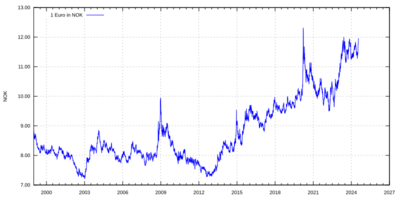
The value of the Norwegian krone changes a lot compared to other currencies. This is mainly because of changes in oil prices and interest rates. Norway is a big oil exporter, so oil prices really affect its money.
In 2002, the Norwegian krone became very strong against the United States dollar and the euro. For example, in July 2002, 100 kroner were worth about $13.7. This was partly because interest rates were high and oil prices were also high.
In 2005, oil prices reached over $60 per barrel. Even though interest rates were lower, the Norwegian krone became even stronger.
However, the value of the krone can also go down. In late 2007 and early 2008, the dollar became weaker. The krone became very strong against the dollar, with one dollar being worth about 5 kroner in April 2008. But by October 2008, the dollar had recovered.
The krone's value keeps changing. For example, during the COVID-19 pandemic, the krone's value dropped a lot. On March 19, 2020, one dollar cost 12.00 kroner.
Current NOK exchange rates
| From Google Finance: | AUD CAD CHF EUR GBP HKD JPY USD DKK SEK |
| From Yahoo! Finance: | AUD CAD CHF EUR GBP HKD JPY USD DKK SEK |
| From XE.com: | AUD CAD CHF EUR GBP HKD JPY USD DKK SEK |
| From OANDA: | AUD CAD CHF EUR GBP HKD JPY USD DKK SEK |
| From fxtop.com: | AUD CAD CHF EUR GBP HKD JPY USD DKK SEK |
See also
 In Spanish: Corona noruega para niños
In Spanish: Corona noruega para niños
- Danish krone
- Economy of Norway
- Icelandic króna
- Scandinavian Monetary Union
- Swedish krona




